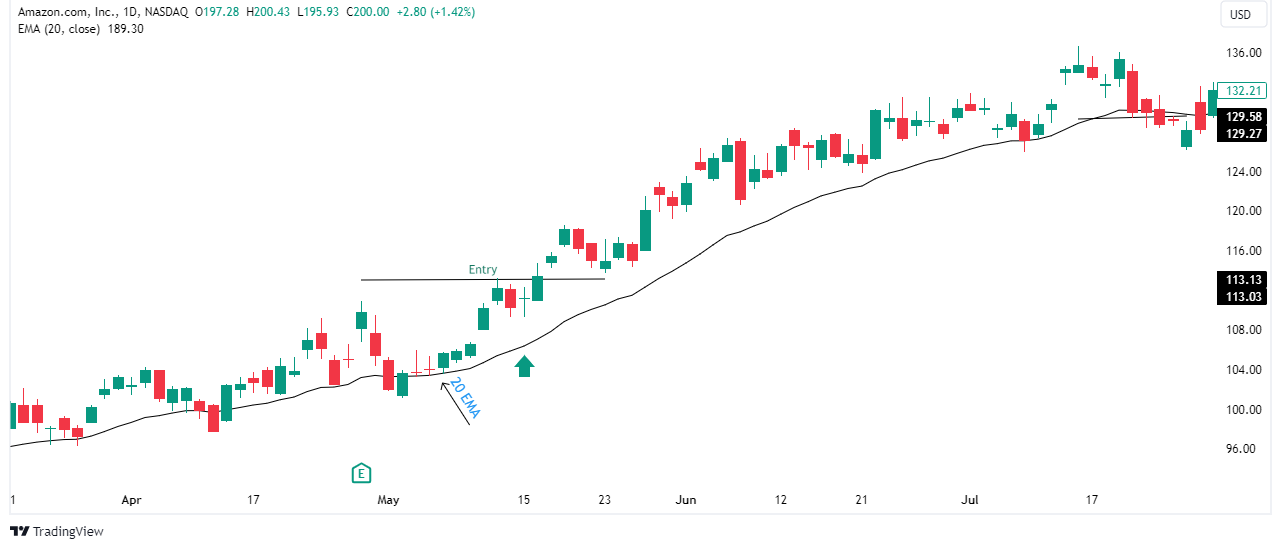The Secret EMA Strategy is a trading tool that analyzes price movements using the 20 EMA method, providing market direction information and support/resistance levels. It’s ideal for short-term and intraday trading.
Are you a trader or an investor?
You’ve undoubtedly heard of the Exponential Moving Average (EMA) before. But did you know that a single moving average may overcome previous failures and lead to significant profits?
Have you ever tried watching what occurs after the market passes the 20 EMA and then retraces slightly?
If the price continues in the same direction and exceeds the prior high or low, a protracted rally may occur. This single signal can significantly boost your profits.
What Is the Exponential Moving Average in Simple Words?
The Exponential Moving Average (EMA) is a moving average that gives more weight and relevance to the most recent data points. The EMA reacts faster to recent price movements than the Simple Moving Average (SMA), which gives equal weight to all data points in the timeframe.
How to Use EMA in Trading
1. Identify the Trend
When the price is above the 20, 50, or 100 EMA, it indicates an uptrend.
When the price falls below the EMA, it signals a downturn.
2. Look for the Crossover
A crossover happens when the price moves above or below the EMA. This may be a hint to enter a trade.
3. Wait for a Retracement
After the crossover, expect a minor retracement (a temporary reversal in the opposite direction of the trend).
4. Confirm Trend Continuation
If the price moves in the direction of the original trend, exceeding the prior high or low, it confirms the trend’s constancy.
Secret EMA Strategy
We all study different strategies for analyzing price movements on charts. However, there are situations when you may not receive the expected profits. Does this sound familiar?
But is it really necessary to be highly skilled to become a great trader? Perhaps not.
Did you realize that a single successful trick might result in big profits? Yes, the key to success is to follow the 20 EMA method. What’s the trick?
The Trick: Using the 20 EMA
Imagine the market has been trading below the 20 EMA for an extended period of time, or the price has entered a range-bound phase. What happens next?
Consider this: as the price begins to rise and cross the EMA, it is time to begin the countdown. This might indicate that a big profit opportunity is on the horizon.
As the price rises, it frequently gravitates back towards the EMA, like a magnet. Consider what happens at this stage.
- Price falls below the EMA again: The price may cross the EMA and continue declining.
- Price bounces up from the EMA: After touching the EMA, the price may restart upward momentum.
- Price failed to reach the EMA: This is the most significant scenario. When the trend is strong, the price may not even reach the EMA before going upward.

AMZN DAILY CHART
Key Moment
Have you ever noticed what occurs when the price exceeds the prior high without reaching the EMA following a modest correction (retracement)? It’s frequently a hint that the price is preparing for a strong surge. Naturally, you may use the price strategy to invest in your preferred stocks.
Long and Short Positions
Long Position: After the EMA crossing, if the price retraces somewhat but does not hit the EMA before surpassing the previous high, it’s an ideal moment to consider establishing a long position.
Short Position: The situation is reversed for short positions. When the price begins to decline and passes below the EMA after a minor retracement without hitting it, you might consider placing a short position.
This approach allows you to properly forecast market changes and make educated trading decisions. Remember that when the price crosses the EMA and retraces slightly without touching it before exceeding the previous high or low, it is a strong indication to enter a trade.
Which EMA Is Best for Trading?
Are you familiar with the 20 EMA for trading?
This EMA signal can provide strong information on market direction.
The 20 EMA is well-known for its ability to indicate market trends. Many traders rely on it. This EMA is ideal for both short-term and intraday trading.
The 21 EMA is also an excellent option and is quite similar to the 20 EMA. It is popular with traders for short-term and intraday trading.
The 50 EMA is ideal for positional trading. It is very powerful to identify the trend over a slightly longer period of time.
The 100 EMA is particularly useful for long-term investments. It gives a larger picture of the market trend.
EMA can provide guidance on market price direction, regardless of the parameters considered. It not only predicts trends but also serves as a support and resistance level, allowing you to make better-informed trading decisions.
Exponential Moving Average Formula
EMA today = (2/n+1)*(Price today-EMA yesterday) EMA yesterday
Where
n = number of periods
Price today = current price
EMA yesterday = MA value of the previous period
Example Calculation
Let’s calculate a 5-day EMA with the following prices:
Day 1: 50
Day 2: 52
Day 3: 51
Day 4: 53
Day 5: 54
Calculate the initial EMA (which is the SMA for the first period):
SMA= (50+52+51+53+54)/5 = 260/5 = 52
Calculate the multiplier:
Multiplier = 2/n+1 = 2/5+1 = 2/6 = 0.333
Calculate the EMA for Day 6 assuming Day 6’s price is 55:
EMA today= 0.333×(55−52))+52 = (0.333×3)+52 =1+52 =53
Which Is Better EMA or SMA?
Are you deciding between the Exponential Moving Average (EMA) and the Simple Moving Average (SMA)? Let’s look at the differences to help you make an informed decision.
The EMA lends more weight to current prices, making it more sensitive to price movements. This might be useful if you want to record short-term market fluctuations. For example, if the market is volatile, the EMA will react faster, delivering more timely alerts for your trades.
The SMA calculates the average price over a specified period without prioritizing recent prices. This can smooth out pricing data, making it simpler to spot long-term patterns. If you prefer a more steady and less volatile indicator, the SMA can be a better choice.
Finally, the choice between EMA and SMA depends on your trading strategy. Do you prefer to respond quickly to price changes? The EMA can serve as your primary tool. Do you want a smoother, longer-term trend analysis? In that situation, the SMA could be better.
20 EMA Strategy Chart
Have you ever had trouble determining where on the chart to make an entry? Many times, by the time you decide to enter, the price has already shifted dramatically. Or maybe you have trouble choosing how much profit or loss to take. Yes, just give it a minute, and one EMA will fix all of these problems.
When trading, utilize the 20 EMA as both support and resistance.
Bullish Market Strategy
First, when the market enters a positive trend after a period of decline and the price on the chart crosses above the 20 EMA, you should wait.
Wait for the price to take support at the 20-EMA. Then you can begin a long position when the price reaches support and then surpasses the previous high.
Bearish Market Strategy
In a down market, the scenario is exactly opposite.
Entry Point: Use the 20 EMA for resistance. When the price encounters resistance and then falls below the previous low, you can open a short position.

20 EMA Trading Strategy/BANKNIFTY 3min
Setting Stop Loss
Now, how do you calculate your stop loss? The EMA can also help to fix this problem.
Long Positions: Imagine you are holding a long position. As prices rise, there will come a time when the market closes below the EMA. This is your cue to be careful. Set your stop loss at the last candle’s low point. If the price continues to fall below the EMA the next day, you should take your profits.
For short positions: Short positions work in the opposite direction. If the price crosses over the EMA and closes, you should be cautious.
In both scenarios, the EMA assists you in determining when to quit your trade, allowing you to maximize your earnings while minimizing your losses. This basic yet powerful method will greatly improve your trading decisions and outcomes.
Following these techniques will allow you to use the 20 EMA to identify the greatest entry points, create effective stop losses, and confidently navigate both bullish and bearish markets.
Final Thoughts
Give the EMA only one minute of your time, and it will show you how to make your ideal trade. This tool is extremely useful not only for trading but also for determining entry and exit points in investments.
When dealing with long-term investments, going from the 20 EMA to the 50 or 100 EMA may be quite useful, just as it is with larger period charts.
You should always be careful, especially when the market is moving sideways. In a range-bound market, the EMA, like other indicators, will not be of much assistance.
Disclaimer
This article is provided for informational purposes only and does not offer financial advice. Trading and investing involve risk, and past performance is not a guarantee of future outcomes. Before making investment decisions, readers should conduct their own research and consider their individual circumstances. The author and platform are not responsible for any financial losses or damages resulting from the use of this information. Get personalized advice from a trained financial counselor.













Leave a Reply